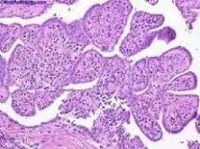 |
| Cancer in the lining of the lung |
If the lung lining cancer near the pleura is localized (i.e. is only found in the mesothelium where it originated) than typically it is not fatal and can often be completely removed via a surgical procedure. Additionally, localized pleural mesothelioma may or may not be caused by asbestos exposure. However, if it has spread to other parts of the body, for instance the lymph nodes, lungs, chest wall, or abdominal organs, then it is considered malignant and is more often than not the result of asbestos exposure.
Asbestos exposure is thought to be responsible for roughly 75% of all cases of lung lining cancer. Those who worked in "at risk" industries during or before the 1970s frequently ingested harmful asbestos fibers that penetrated deep within the layers of the lungs. The body is unable to dispel these fibers, which eventually cause an inflammatory condition in the lungs (asbestosis). This condition worsens and eventually becomes malignant.
A typical lung cancer grows as a single distinct mass which is generally anywhere from the size of a grape to the size of a baseball when discovered. Because most lung cancers grow as a solitary defined mass, sometimes they can be surgically removed and a follow up of chemotherapy or radiation treatment may succeed in removing the cancer all together.
In contrast, mesotheliomas grow on the lining of the lung (or the lining of the abdomen) as a diffuse multi-site tumor with masses being spread on a wide area of the pleura. Even when an individual undergoes surgery for removal of the entire pleura, the entire lung where the mesothelioma is located, and parts of the diaphragm, this almost never results in total removal of the cancer.
Lung lining cancer is usually diagnosed by x-rays and CT scans but may also be diagnosed by tissue biopsy, pleural tap, and fiberoptic examination. Its symptoms are: persistent cough, sputum streaked with blood, chest pain, recurring pneumonia or bronchitis.
Chemotherapy, radiation, or surgical treatment, when used independently, are often ineffective in treating cancers of the lung lining. Combined approaches that use these therapies together as well as new drugs that specifically target the genetic material in mesothelioma cells are currently being tested.